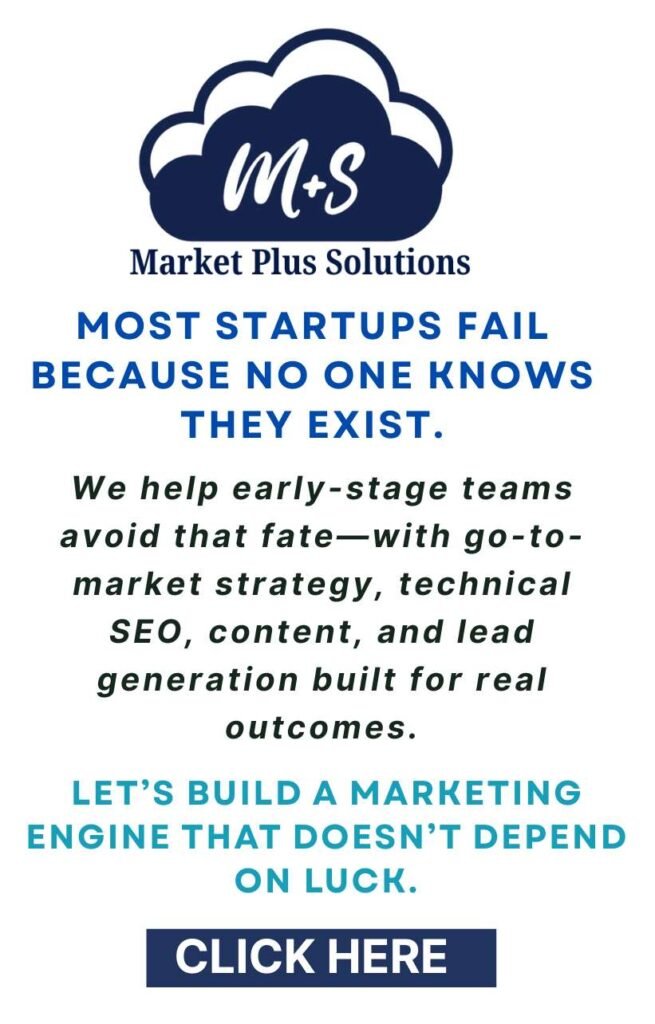Why IT Startups Fail: The Hard Truth
Why Do So Many IT Startups Fail?
We’re not here to rehash the usual post-mortem checklists. If you’re an IT or SaaS founder, you’ve seen them all before—product-market misalignment, cash flow issues, team dysfunction, and so on. The reality is, most founders already know what not to do. You’ve read the post-mortems, followed the frameworks, and watched the same cautionary tales unfold.
And yet, the same patterns keep repeating. (According to CB Insights, 90% of startups fail, and many don’t survive beyond their first few years. These aren’t outliers, they follow a pattern.)
We’ve worked with enough IT and SaaS startups to spot the trend. And one of the most common—and costly—mistakes we see? Founders trying to salvage a struggling startup by hiring a marketing agency when it’s already too late.
By the time many IT and SaaS startups bring in an external digital marketing agency—often using the last of their available budget—it’s already too late. Not because the internal marketing team failed, and not because the freelancers didn’t deliver, but because the company waited too long or approached marketing with the wrong mindset from the start.
When there’s still funding in the bank, marketing is often treated casually.
Startups try to save money by hiring junior marketers or inexperienced agencies based on cost, not strategic fit. But more often, the problem is that founders don’t know how to lead a marketing team or set direction. There’s no clear strategy, no ownership at the top, and no framework to evaluate what’s working.
It’s not a failure of execution—it’s a failure of leadership. And while it may be uncomfortable to admit, it’s a reality many IT startup founders eventually have to face.
Market Plus Solutions has worked with many early-stage tech companies—some on the rise, others trying to recover lost ground. And the question we hear more often than any other is this: Can digital marketing save a failing IT startup? Is there a guarantee?
Can digital marketing save a failing IT startup?
Of course not—there’s no guarantee. But for many IT startups, digital marketing becomes the last lever worth pulling—it can mean the difference between shutting down quietly and turning things around strategically.
Before we go further, it’s worth pausing on a principle that’s often overlooked in technical circles: “It’s not just what you say—it’s how you say it.”
In B2B tech, this isn’t just a communication tactic—it’s the foundation of your go-to-market strategy.
You might have a robust architecture, a technically sound product, and a clearly defined market. But if your messaging is buried in jargon, feature lists, or abstract logic, your audience won’t engage.
Buyers don’t want a spec sheet. They don’t care how elegant your backend is or how scalable your infrastructure might be. They want one thing: “How does this solve my problem?” That could mean saving money, driving revenue, reducing risk, saving time, or helping them move faster than their competitors.
And this disconnect—between technical capability and market clarity—is what quietly derails most IT startups.
Buyers don’t want a spec sheet.
They don’t care how elegant your backend is or how scalable your infrastructure might be. They want one thing: “How does this solve my problem?” That could mean saving money, driving revenue, reducing risk, saving time, or helping them move faster than their competitors.
And this disconnect—between technical capability and market clarity—is what quietly derails most IT startups.
So, what’s surprising is that it rarely comes down to weak products. Most failed startups are built by highly capable teams solving real problems. The failure lies in something far more fundamental: the inability to convert innovation into visibility, traction, and growth.
After months—sometimes years—of product development, most founders still can’t answer the essential question: How will people discover, understand, and buy this?
And so, when the product finally launches, there’s silence—no one knows it exists or sees its relevance. And, by the time that realization sets in, the budget is gone, the pipeline is dry, and the momentum has vanished.
This isn’t a development issue. It’s a go-to-market failure. Which brings us back to the real question: Can digital marketing save a failing IT startup? In many cases, yes.
Common Themes Behind Why IT Startups Fail
Failure in IT startups rarely comes from a single catastrophic decision. It builds gradually—through small misalignments, overlooked red flags, and a lack of strategic structure. While every company’s story is unique, the patterns behind why most IT startups stall (or fail altogether) are surprisingly consistent.
Here are four of the most common breakdowns:
- Confusing Positioning: Most tech founders are brilliant engineers, deeply connected to their product. But that closeness can be a weakness. They’re often great at explaining how their solution works—but struggle to communicate why it matters to the buyer. If your messaging doesn’t speak to their pain or their priorities, they won’t stick around long enough to care.
- Zero Demand Generation: You can’t sell what no one knows exists. Many startups go live without a plan to create awareness. There’s no inbound strategy, no content foundation, no outbound motion, and no consistent messaging in the market. Instead, early growth leans on word-of-mouth, a founder’s personal network, or one-off opportunities.
- No Repeatable Lead System: Random lead flow isn’t growth—it’s noise. Most struggling startups lack a structured, measurable system to attract, nurture, and convert prospects. There’s no funnel, automation, or qualification. That leaves the sales team chasing cold leads—or worse, waiting for them. And once fundraising slows or founder energy burns out, the pipeline dries up.
- Burning Through Budget: Here’s where the damage compounds. Instead of building long-term marketing infrastructure, many startups chase quick wins: paid ads without strategy, pricey PR firms with no clear ROI, or tools that don’t move the needle. By the time they realize those channels aren’t sustainable, the budget is gone—and they haven’t built anything that compounds over time, like SEO or evergreen content.
Again, these common scenarios bring us to the same question: Can digital marketing save a failing IT startup? Or more specifically—is it capable of reversing the trajectory of a struggling tech company before the runway runs out? And perhaps the more important question: Do digital marketing experts think differently than most IT founders—and could that shift in mindset be the deciding factor between failure and recovery?
No One Understands the Product (Even the Target Audience)
You’ve built a technically solid solution. Maybe even something your engineering team is proud of. But if your messaging is too complex, too abstract, or rooted in internal jargon, it won’t land. And if your target audience can’t immediately understand what your product does, why it matters, or how it fits into their world—they won’t engage.
This is where many IT startups quietly stall.
They spend months refining features but fail to articulate outcomes. Instead of showing how the product solves a real-world problem, they explain how it was built—assuming buyers think like developers.
But your audience doesn’t want a technical breakdown. They want relevance. Whether you’re selling to a CIO, a department head, or a founder of another startup, they’re asking one thing: How does this help me solve a problem, reduce risk, or unlock growth?
Here’s where messaging typically breaks down:
- Overly technical language that alienates non-technical decision-makers.
- No clear value proposition—nothing that answers the simple question: “What’s in it for me?”
- Poor market positioning that makes it difficult to compare your product against alternatives or legacy systems.
This is exactly where a digital marketing agency—one that understands B2B IT—can provide immediate value. They don’t just clean up copy. They rethink how your product is positioned, how your narrative aligns with real buyer intent, and how to communicate complex solutions in ways that decision-makers actually care about.
No Demand, No Traction — The Product-Market Fit Problem
One of the most common—and most avoidable—reasons IT startups fail is a lack of true product-market fit.
It sounds basic, but it’s where many teams go wrong. Instead of validating demand early, they dive straight into product development. Features get added. Interfaces are refined. Backends are optimized. But there’s no evidence that anyone actually wants the solution.
The result? A polished product with no market pull.
In many cases, these startups are building a solution in search of a problem. Founders make assumptions based on their own experience or intuition. They skip user interviews. They ignore competitive dynamics. They rely on “we think” instead of “we know.” And when the launch flops, the team scrambles to retro-fit the product into a space it was never designed for.
Here’s where things typically break down:
- Customer research is skipped—or done far too late.
- Competitive analysis is ignored, leading to a product that feels indistinct in the market.
- Product decisions are driven by assumptions, not evidence from real users.
This is where the right digital marketing agency can shift the entire trajectory—before the first dollar is wasted on development. A smart agency helps validate the market early. They run real keyword and trend analysis, map customer intent, and test how your messaging performs before launch. You don’t just get leads—you get insight. When done right, digital marketing becomes a feedback loop—not just a megaphone. It tells you if you’re building something people are already looking for, or if you’re investing in a product no one’s asking for.
Poor Visibility in a Noisy Market
In B2B tech, having a better product isn’t enough. You’re not just competing with other startups—you’re trying to get noticed in a space crowded with legacy platforms, enterprise vendors, and industry voices that already dominate the conversation. Even if your solution is smarter, faster, or more affordable, it won’t matter if no one knows you exist.
Too many IT startups operate in stealth for far too long. They rely on founder networks, early adopters, or a few good reviews to carry the weight. But in today’s digital environment, that approach simply doesn’t scale. Visibility is no longer optional—it’s table stakes.
Here’s where most startups fall short:
- There’s no SEO or content strategy, so they’re invisible in search—where most buyers start their journey.
- Social media and paid acquisition are afterthoughts, meaning key decision-makers never come across the product.
- Growth depends entirely on referrals or word-of-mouth, which eventually dry up.
This is exactly where a strategic digital marketing partner proves invaluable. A skilled agency doesn’t just increase visibility—they make it precise. From technical SEO and thought leadership content to LinkedIn outreach and paid campaigns, they help you show up where your audience is already searching, scrolling, and comparing solutions. Because in B2B, visibility without intent is noise. But visibility with the right intent—that’s what drives qualified pipeline.
No Consistent Lead Flow = No Revenue = No Runway
You can’t scale a business on sporadic leads and ad hoc outreach.
Without a consistent, qualified lead flow, your entire operation becomes unstable. It’s not just a revenue problem—it’s a runway problem. And in early-stage startups, every month without traction burns cash you can’t get back.
Far too many IT startups rely on founder-led sales in the early stages. It works—until it doesn’t. Deals get stuck. Networks run dry. Founders get pulled into product, hiring, or investor conversations. Without a scalable system in place, momentum stalls just when it matters most.
Here’s where the process typically breaks down:
- Sales depend entirely on the founder’s time, energy, or network—which isn’t scalable.
- There’s no structured marketing funnel or nurturing flow, so prospects drop off after the first touch.
- Outreach is inconsistent or untargeted, leading to low conversion rates and wasted effort.
This is where a high-performing digital marketing agency delivers measurable impact. They don’t just generate leads—they engineer a repeatable, scalable lead generation engine. Through SEO, content strategy, paid campaigns, and marketing automation, they create systems that work whether the founder is in back-to-back calls or not even in the room. Done right, digital marketing becomes more than a growth lever. It becomes your foundation for predictability—and your insurance against stagnation.
Burned Budget, Zero Results
This is where failure gets expensive. IT startups often waste their limited runway chasing fragmented marketing tactics without any cohesive strategy. They run paid ads with vague targeting, hire freelancers with no direction, or jump on whatever platform is trending that month—hoping something clicks. But hope isn’t a strategy, and in most cases, it doesn’t pay off.
Instead of building a system that compounds, they get distracted by metrics that don’t matter. Impressions, clicks, follower counts—these are easy to track, but they rarely translate into pipeline. When the budget dries up, there’s nothing sustainable left behind. No qualified leads. No market positioning. No clear insight into what worked and what didn’t.
Here’s where things typically go wrong:
- Marketing is fragmented and reactive, driven by short-term needs instead of long-term strategy.
- The team chases trends—new tools, AI gimmicks, or viral content—without questioning whether they align with business goals.
- ROI is either not tracked or misinterpreted, leaving leadership in the dark about what’s driving (or draining) growth.
This is exactly where a performance-driven digital marketing agency adds value. The right partner doesn’t just deliver services—they build a strategy tied directly to outcomes. From lead quality to acquisition costs and conversion timelines, every move is measured. Every channel has a purpose. Every dollar is tracked against business impact.
Conclusion — Can Digital Marketing Save a Failing IT Startup?
The right partner can be the turning point.
Building a solid tech product is only half the equation. The other half—getting that product seen, understood, and adopted—is what separates functional software from a viable business. In today’s saturated B2B landscape, visibility and traction aren’t side benefits. They are survival factors.
And, this is where digital marketing moves from an operational support role to a strategic lever. It’s not just about pushing content or running campaigns. It’s about defining your go-to-market motion, validating demand, and aligning your product with real buyer intent—early, consistently, and at scale.
So, can digital marketing save a failing IT startup? In many cases, it’s the only thing that can—because it forces founders to translate technical value into market relevance, at exactly the moment when time and cash are running out.
A focused, data-driven marketing partner doesn’t just improve positioning or polish your pitch. They give your startup the clarity to communicate, the channels to scale, and the systems to build pipeline. And when the product is sound but the business is faltering, those three levers are the difference between shutting down and breaking through.
Finally, can digital marketing save a failing IT startup?
Yes—it can.
Especially, if it’s grounded in strategy, executed with precision, and aligned with outcomes that actually move the business forward. In a market where 90% of startups fail, that’s not an experiment. It’s a necessity.





